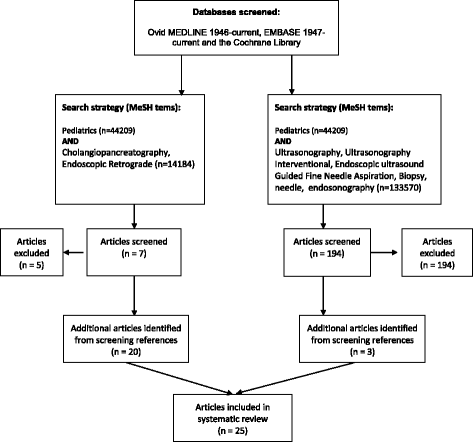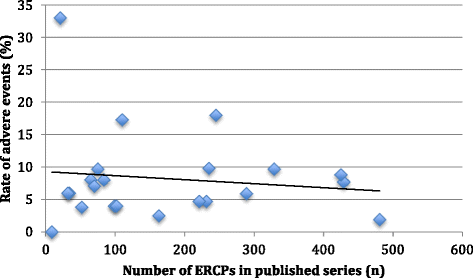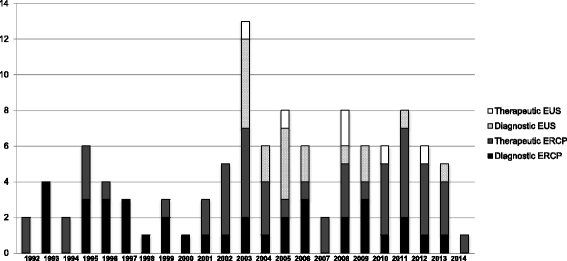Paediatric pancreaticobiliary endoscopy: a 21-year experience from a tertiary hepatobiliary centre and systematic literature review
- PMID: 29426291
- PMCID: PMC5807847
- DOI: 10.1186/s12887-017-0959-9
Paediatric pancreaticobiliary endoscopy: a 21-year experience from a tertiary hepatobiliary centre and systematic literature review
Abstract
Background: In adults ERCP and endoscopic ultrasound (EUS) are standard methods of evaluating and treating many hepatopancreaticobiliary (HPB) conditions. HPB disease is being diagnosed with increasing frequency in children but information about role of ERCP and EUS and their outcomes in this population remain limited. Therefore the aims of this study were to describe the paediatric ERCP and EUS experience from a large tertiary referral HPB centre, and to systematically compare outcomes with those of other published series.
Methods: All patients <18 years undergoing an ERCP or EUS between January 1992-December 2014 were included. Indications for the procedure, rates of technical success, procedural adverse events and reinterventions were recorded in all cases.
Results: Ninety children underwent 111 procedures (87 ERCPs and 24 EUS). 53% (48) were female with a median age of 14 years (range: 3 months - 17 years). Procedures were performed under general anaesthesia (n = 48) or conscious sedation (n = 63). Common indications for ERCP included chronic or recurrent pancreatitis and biliary obstruction. Patients frequently had multiple comorbidities, with a median ASA grade of 2 (range 1-4). Therapeutic procedures performed included biliary or pancreatic sphincterotomy, common bile duct or pancreatic duct stone removal, biliary or pancreatic stent insertion, EUS-guided fine needle aspiration and endoscopic transmural drainage of pancreatic fluid collections. No adverse events were reported following ERCP but there was one complication requiring surgery following EUS guided cystenterostomy.
Conclusion: ERCP and EUS in children and adolescents have high technical success rates and low rates of adverse events when performed in high volume HPB centres.
Keywords: Biliary leak; Choledocholithiasis; Chronic pancreatitis; Cystic lesion of the pancreas; Endoscopic retrograde Cholangiopancreaticography (ERCP); Endoscopic ultrasound (EUS); Paediatric; Pancreatic fluid collection; Primary sclerosing cholangitis; Transmural drainage.
Conflict of interest statement
Ethics approval and consent to participate
The study protocol was reviewed against the UK Health Research Authority definitions of research and was deemed to primarily be an evaluation of clinical service and therefore did not require formal ethical approval for the study or access to the clinical databases used in the study [35]. It was registered as a clinical audit project at University College London Hospitals. All patients received standard treatment in accordance with local and national guidelines, where available.
Consent for publication
Not applicable.
Competing interests
The authors declare that they have no competing interests.
Publisher’s Note
Springer Nature remains neutral with regard to jurisdictional claims in published maps and institutional affiliations.
Figures




References
-
- Classen M, Phillip J. Endoscopic retrograde cholangiopancreatography (ERCP) and endoscopic therapy in pancreatic disease. Clin Gastroenterol. 1984;13(3):819–842. - PubMed
-
- Scheers I, Ergun M, Aouattah T, Piessevaux H, Borbath I, Stephenne X, De Magnee C, Reding R, Sokal E, Veyckemans F, et al. The Diagnostic and Therapeutic Role of Endoscopic Ultrasound in Pediatric Pancreaticobiliary Disorders. J Pediatr Gastroenterol Nutr. 2015;16(2):238–47. - PubMed
Publication types
MeSH terms
Grants and funding
LinkOut - more resources
Full Text Sources
Other Literature Sources
Medical

